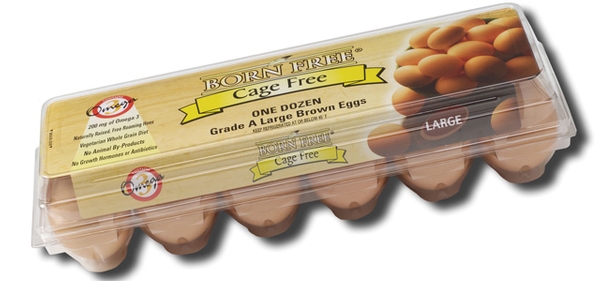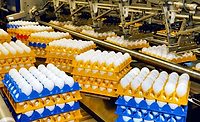Radlo Foods Hatches a High-Tech Egg Safety Plan

If food companies with proactive food safety programs could be said to have a pecking order, Radlo Foods LLC would be at the front of the flock. Ahead of the U.S. Food and Drug Administration’s (FDA) development of a final rule on egg safety slated for publication in 2006, the Watertown, MA-based agricultural products producer, distributor and supplier is one of the first companies in the nation to develop and implement a new comprehensive egg safety action plan that closely follows the main elements of the proposed regulation.
The Department of Homeland Security’s identification of eggs as one of the five most likely targets for agro-terrorism, coupled with FDA’s high-priority focus on mandating measures to reduce the number of Salmonella Enteriditis related illnesses linked to egg consumption, is driving even greater demand for traceability and controls over egg production in the U.S. Radlo
Foods’ response to that demand is a program that includes state-of-the-art laser etching traceability technology; pullet vaccinations; flock testing; lower settings for crack tolerance; and premium see-through packaging with a tamper-proof option.
“Our strict quality assurance and safety protocol, together with the laser technology, means that we can proudly stand behind the quality and freshness of Born Free Eggs while contributing to the FDA’s efforts to improve upon our nation’s food safety,” said David Radlo, CEO of Radlo Foods. “Being the first brand in the nation to implement an all-encompassing plan utilizing the hottest and most recent technology to enhance egg safety is very important to us.”
Along with all-natural beef and chicken products and Grown Free brand organic Florida orange juice, Radlo Foods offers natural and organic eggs under its Born Free Eggs label to retailers, wholesalers and export customers in domestic and international markets. Owned and operated by the Radlo family since 1916, Radlo Foods became a founding franchisee of Eggland’s Best brand eggs, for which the company originated the Cage Free and Cage Free Organic lines. Born Free Eggs come from chickens raised on family farms with no exposure to antibiotics or artificial hormones. They are available in four varieties: All Natural, Cage Free and USDA certified Cage Free Organic and Vegetarian Fed.
As the goals of egg safety and food defense become more defined, regulation requiring permanent freshness dating and traceability coding for eggs has gathered widespread support within the egg products industry. And Radlo Foods is gaining widespread attention for its rigorous food safety plan and application of new technology to trace individual eggs from the from farm to fork, giving consumers, auditors and the government greater assurances about the safety of its eggs.
Hatching a Plan for Egg Safety
Egg safety is a serious action item for both the FDA and the U.S. Department of Agriculture’s (USDA) Food Safety and Inspection Service (FSIS), due to potential risks to public health associated with unintentional foodborne illness and to public security in the event of intentional bioterrorism attacks. USDA has responsibility for implementing the Egg Products Inspection Act (EPIA). Under EPIA, FSIS has primary responsibility for the inspection of processed egg products to prevent the distribution of adulterated or misbranded liquid, frozen and dried egg products.
A comprehensive risk assessment conducted in 1998 by a team headed by USDA FSIS estimated that of the 47 billion shell eggs consumed annually, 2.3 million are SE-positive, exposing a large number of people to the risk of illness. The Centers for Disease Control and Prevention (CDC) estimates that, on average, one consumer in 50 could be exposed to a Salmonella-contaminated egg each year. On an annual basis, the serotype Salmonella Enteriditis (SE) causes an estimated 118,000 cases of foodborne illness from consumption of SE-contaminated eggs. While CDC indicates that between 1996 and 2003 the estimated incidence of all Salmonella-associated cases decreased 19%, a substantial decline in the incidence of S. Enteritidis infection between 1996 and 1999 was partially reversed by increased incidence that has remained steady from 2000 through 2004.
In 1999, the Egg Safety Action Plan (ESAP) was created for the purpose of reducing SE infections associated with eggs, outlining two strategies designed to achieve this, one focusing on risk reduction at the farm level along with associated packer/processor controls and the other at the packer/processor level. To meet the goals set forth in the ESAP and cover all aspects of the farm-to-table continuum both FDA and USDA FSIS plan to publish proposed rules outlining measures to be put in place to reduce egg-associated SE infections.
In 2005, FDA announced its intent to hold public meetings on the proposed egg safety rule with an eye toward promulgation in 2006. The agency would require egg safety measures to prevent the contamination of shell eggs with SE during egg production, including:
• Provisions for procurement of chicks and pullets
• A biosecurity program
• A pest and rodent control program
• Cleaning and disinfection of poultry houses that have had an environmental sample or egg test positive for SE
• Refrigerated storage of eggs at the farm
Egg producers also would be required to test the environment for SE in poultry houses. If the environmental test is positive, the proposal would require follow-up egg testing for SE. If the egg test is positive, according to the proposal, eggs would be diverted from the table egg market to a technology or process that achieves at least a 5-log destruction of S. Enteritidis for shell eggs, or to processing in accordance with the EPIA.
According to FDA, the implementation of the egg safety rule is projected to reduce the number of SE-related illnesses by 33,500, a major step in realizing the Healthy People 2010 public health goal of a 50% reduction in all salmonellosis and a 50% reduction in SE outbreaks by 2010.
By incorporating the elements of the agency’s proposed rule into its own egg safety program, Radlo Foods means to claim a leadership role in the egg products industry. With the additional safety and quality assurance promised by the unique date and traceability code etching technology used in its program, the company is taking egg safety from the coop to a coup in gold standard product safety.
Now That’s Using Your Egg
To accomplish the first step in the company’s six-step egg safety plan, Radlo Foods partnered with Deerfield, IL-based EggFusion, which provides the only USDA accepted solution for applying permanent, tamper-proof laser-etched freshness and traceability codes on the surface of each eggshell.
EggFusion’s technology enables permanent etching of an expiration date and traceability code onto individual shell eggs that can be used to look up additional data points regarding the egg’s origin and distribution. A high-energy light beam etches codes onto the shell of each egg during the packing process, removing less than 10 percent of the egg shell where the mark appears. The contents of the egg remain untouched and the shell’s strength is unaltered. “Because the code is etched on, it is tamper-proof, unlike ink-based codes which can be removed or altered,” says Shaun Emerson, CEO of EggFusion.
The law for egg processors already requires all egg packages to bear nutrition information; the name and address of the packer or distributor; the date of packaging; the net contents; and the official USDA inspection mark and plant number. However, once the eggs are removed from the carton, all of that information is lost. The freshness codes that Radlo Foods etches onto its eggs provide consumers with a new tool for validating the freshness of each individual egg, while the traceability codes will allow consumers and government officials to trace an egg back to its source.
“Our goal is to gather as much relevant information as we can that would be useful to the retailer, government, producer and consumer,” Emerson says.
The etching is as much about meeting consumer demand as it is about accommodating government expectations, Radlo adds. “A lot of consumer groups are asking for egg traceability.” He points to concerns about consumers’ inability to verify the freshness of individual eggs and their fears that eggs are being repackaged in new cartons to appear fresh.
By putting dates on the eggs themselves, not just the cartons, consumers have greater assurances in the freshness of the egg. And, in the event of a recall, consumers still have data in place to check the eggs in their refrigerators against a recall number. “If someone were to get sick, we can do immediate traceback using the etched codes,” Radlo says. “We can find out where the food is and segregate it.” It also enables the company to recall only those eggs at risk, preventing the high costs associated with a broader recall.
To perform the laser etching, EggFusion first works with the egg production facility to define the grade of eggs being produced, the speed and power of the production line and the number of lines working simultaneously. For Radlo Foods, because freshness and traceability codes are used, two lasers are integrated with each egg grader, etching the eggs simultaneously at the speed of production.
The etched codes are linked back to a central database that collects and stores key data about the egg production, Emerson says. The code includes data about the producer, the time and date it was run, which grader and packing lane was used, and its status as organic, cage free, vegetarian fed, and so on. It also includes environmental data, such as feed used, food safety protocols followed, vaccinations, temperature during storage, and pH level of the water used to wash the eggs, as well as where the final product was shipped. “When we etch a code on an egg, it links all of the data regarding the production of that egg to the producer’s data storage system,” Emerson says. “It’s a tamper-proof tool that lets us be proactive in either direction.”
Some of the data, such as the cold storage temperature, is collected automatically through wireless sensors in the plants, while other information, such as where it was shipped, must be manually entered by the producer. The data is currently stored for at least six months in a central data repository in Denver, CO.
Vaccinations and Testing
The laser etched codes are the most dazzling element of Radlo Foods’ five-point egg safety plan; however, each step in the program is critical to the overall safety of its egg products. The second step in the program involves hen health. Radlo follows the Pennsylvania Egg Quality Assurance Program (PEQAP) guidelines for egg safety, which includes vaccinations, Salmonella testing, rodent control programs, and diversion programs if problems arise.
During the growing and hatching phase of the hens’ lives, vaccinations and regular testing ensure SE is kept at bay. The chicks are purchased only from breeders who have undergone U.S. sanitation monitored SE testing to prove the breeder flocks are free of the pathogen. “That’s key to any healthy chicken program,” says Tom Shea, Radlo’s operations manager.
The chicks arrive in paper lined boxes, and every tenth chick’s paper is swabbed and tested for SE to verify its health and that no contaminants from the hatchery are being transported to the growing house, where they live for the first 10 to 15 weeks of their lives. That poultry house, which accommodates 20,000 to 100,000 chicks, is regularly swabbed for SE and utilizes a strict rodent control management program.
All of the chicks roam free in the house, but stay in an enclosed, covered area to protect them from disease and contaminants that can be contracted when the birds roam free outside. “You can’t control disease in a completely open environment,” Shea says, noting that water fowl and other wild animals can carry dangerous bacteria and disease.
On the day they are born, the chicks receive their first SE spray vaccine. While in the growing house, they receive two more vaccines at seven weeks and 14 weeks, which are water-based. All of the initial vaccines use live viruses; however, if an environmental swab indicates the presence of SE during the growth phase, they may be given a kill vaccine at 17 weeks.
Once in the laying house, environmental samples are taken every 10 to 12 weeks. Along with nests, walls, floors and conveyors, the chicks’ feed is tested to ensure it is free from bacteria. Chicks are also tested for SE at the end of their lives, prior to exiting the laying house. All testing is conducted by a third party auditor to ensure validity.
“Through continuous testing for SE during the life cycle of the hen, the Born Free specifications provide further assurance that the eggs produced are safe,” Shea says. “If there is a positive environmental test of the farms, the eggs are tested.If the test is positive, all of the eggs in that pool are diverted to pasteurization or hard cooking.”
If eggs are diverted, Shea will ramp up the SE testing program in accordance with the Born Free Egg Safety Action Plan program. According to the program, to be able to resume sale of eggs as table eggs, 1,000 eggs must be tested in pools of 20 every two weeks for four lots of samples and test negative. Alternatively, if less than 50 percent of the environmental tests and no more than one egg pool are positive, 4,000 eggs may be tested at one time. Following return to the table egg market, 480 eggs are sampled each month for the life of the flock.
Cracking and Packing
Once eggs are laid, they are washed, dried and carried to the etching and packing area. Before being placed in cartons, the eggs also go through a crack scanner. Radlo Foods requires lower settings on crack checking equipment for its Born Free Eggs than most standard egg processors. “This reduces the number of cracked eggs that reach the retail location,” Radlo says. “We realize customers want to be able to make their egg selection quickly and feel confident that the eggs are packed without the cracks that current practices allow.”
The USDA allows for up to five percent cracked eggs in a lot, and seven percent if the eggs are jumbo. Radlo strives for two-to-three percent cracked, with the ultimate goal of zero. To reduce cracks in finished eggs, the crack detector on the processing line is set to zero tolerance. Any eggs with cracks are diverted from table egg production. “By setting our tolerance at zero it allows for a two to three percent crack tolerance as a result of shipping and handling,” Radlo says.
He hopes that by reducing the cracks in eggs, consumers will be more comfortable buying eggs without opening the cartons and handling them. To encourage consumer confidence, Radlo Foods uses a three-piece, clear egg carton that provides superior protection of the egg shell integrity, while giving consumers a full view of the eggs so they can look for cracks without raising the lid.
The tri-fold carton also comes with an optional tamper-proof feature that allows the carton to be sealed by applying heat to the corners, preventing the cartons from being opened. However, surveys show that consumers are not yet ready for that. “Our data shows that 97 percent of consumers still want to open the carton and see the eggs for themselves,” he says.
He hopes the clear cartons and ongoing experience with fewer cracked eggs will eventually win them over, both to reduce damage from consumer handling and to ensure the utmost food safety. “Ideally, we’d like to get to the point where the eggs drop onto a conveyor, where they are cleaned, dried, placed into cartons and sealed without being touched by anyone but the consumer who buys the product,” Radlo says. “Human touch is where problems happen. Whether it’s unintentional breakage or terrorist attacks, a sealed carton would prevent those problems.”
The final element of the six-step plan addresses the new threat from avian flu. All birds producing Born Free eggs are protected with safeguards from migratory birds, which have been identified as a risk for domestic poultry infection.
Government officials are already applauding Radlo’s efforts to improve egg safety. “The Born Free Egg Safety Action Plan is an example of how the industry can react proactively to improve efficacy,” says August Schumacher, Jr., former U.S. Under Secretary for Farm and Foreign Agricultural Service. “It will help provide Americans with safe and secure food.”
Sarah Fister Gale is contributing editor to Food Safety Magazine.
Looking for a reprint of this article?
From high-res PDFs to custom plaques, order your copy today!








